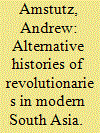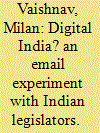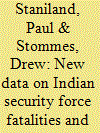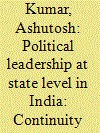|
|
|
Sort Order |
|
|
|
Items / Page
|
|
|
|
|
|
|
| Srl | Item |
| 1 |
ID:
167569


|
|
|
|
|
| Summary/Abstract |
This review essay discusses two recent monographs on revolutionaries and political violence in South Asia, Kama Maclean’s A Revolutionary History of Interwar India: Violence, Image, Voice and Text (2015) and Durba Ghosh’s Gentlemanly Terrorists: Political Violence and the Colonial State in India, 1919-1947 (2017). Ghosh and Maclean’s books contribute to an expanding body of scholarly work on anticolonial politics in India, a rich historiography on liberalism in the British Empire, and studies of visual culture and oral histories in modern South Asia. Specifically, Maclean’s A Revolutionary History centers on the Hindustan Socialist Republican Army (HSRA) in Punjab and Delhi in the late 1920s and early 1930s. Maclean reconfigures the political terrain of India’s independence struggle and illustrates the importance of revolutionary violence in nonviolent politics through unstudied visual sources and oral histories. In turn, Ghosh’s Gentlemanly Terrorists focuses on Bengal, particularly revolutionaries in the Anushilan Samiti and Jugantar from 1919 to 1947. Complicating the history of colonial constitutionalism as a gradual expansion of rights and representation, Ghosh demonstrates how constitutional reforms that aimed to promote liberal governance in India were tied to repressive emergency legislation. This review essay addresses how Gentlemanly Terrorists and A Revolutionary History contribute to ongoing efforts to rethink both the political chronology and the wider political landscape of interwar India by incorporating revolutionaries into the story of independence. It also considers how Maclean and Ghosh creatively utilize non-state archives and vernacular sources, in conjunction with colonial records, to follow the retelling of revolutionary histories in different media.
|
|
|
|
|
|
|
|
|
|
|
|
|
|
|
|
| 2 |
ID:
167566


|
|
|
|
|
| Summary/Abstract |
Of the many tasks elected representatives perform, constituency service is among the most difficult to observe and, therefore, to measure. However, a burgeoning literature uses digital tools such as email to experimentally evaluate the responsiveness of political elites to requests for constituency service. To date, this literature has overwhelmingly focused on the developed world. In this article, we describe the results of an email experiment in which we sent plausible, but fictitious constituency service requests to national legislators in India to evaluate their responsiveness, helpfulness, and possibly discriminatory behavior. While the overall response rate to our request is quite poor, those that do respond tend to offer “meaningful” responses. We find scant evidence of legislators discriminating on religious lines.
|
|
|
|
|
|
|
|
|
|
|
|
|
|
|
|
| 3 |
ID:
167568


|
|
|
|
|
| Summary/Abstract |
National and state-level security forces across India operate against insurgents, criminals, and external threats. These operations are politically consequential, yet these forces tend to be quite opaque. This article provides new data on the fatalities that these forces have suffered in order to explore the location and nature of political violence in India. We create several new datasets of security force fatalities extracted from commemorative security force “martyrs” documents and online databases published by Indian state-level police organizations, the Ministry of Home Affairs (MHA), and the Ministry of Defence, as well as semi-official sources. The data vary wildly in quality and detail, and there are serious limits to their use. Nevertheless, they allow us to – with caveats – measure the location and incidence of violence, as well as the demographic underpinnings of the Indian Army, the two largest MHA paramilitaries, and several state police forces. Caveats aside, we anticipate that subsets of these data are sufficiently high in quality, facilitating future rigorous quantitative analysis on political violence in India. The entire dataset will be made publicly available.
|
|
|
|
|
|
|
|
|
|
|
|
|
|
|
|
| 4 |
ID:
167567


|
|
|
|
|
| Summary/Abstract |
Possible explanations are discussed in this article for the paucity of studies regarding political leadership, especially at the state level, in a well-functioning electoral democracy such as India with many parties and leaders. The article argues that such studies can be useful in making sense of the political and economic changes/shifts and developments of a particular state over a period that may have national impact. The article further argues that there has been a perceptible shift not only in terms of social composition but also in the “language” of politics used by the emergent generation of political leaders cutting across the party lines. The change has coincided with the rise of state-level parties and leaders in the post-Congress era followed by the ascendance of the Bharatiya Janata Party (BJP).
|
|
|
|
|
|
|
|
|
|
|
|
|
|
|
|
| 5 |
ID:
167565


|
|
|
|
|
| Summary/Abstract |
The US and India have become closer in recent times. Compared with the last century, the relationship between the two countries is in steady growth. Under both the Bush and Obama administrations, and now the Trump administration too, India is receiving significant importance in US’ strategic policy toward the Indo–Pacific. India’s emergence as a credible power in the Indian Ocean region has brought both countries much closer. The relationship has also steadily progressed as result of China’s emergence as a potential hegemon in Asia. The US faces difficulty in maintaining its preponderant position across the Indo–Pacific and requires strong allies in the region to help share the burden. In this regard, India could be the offshore balancer in Asia to counter China’s emergence as a potential hegemon in the region.
|
|
|
|
|
|
|
|
|
|
|
|
|
|
|
|
|
|
|
|
|